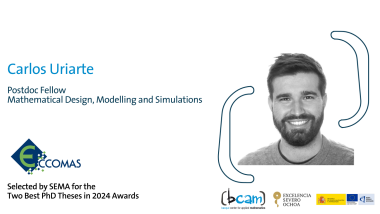Mikel Agirre will defend his doctoral thesis on Wednesday, September 2nd
- Due to the restrictions caused by the COVID-19 pandemic, the defense will be held online and users will be able to follow it live
Mikel Agirre received a Bachelor’s degree in Mathematics from the University of the Basque Country in 2013. In 2014 he obtained a Master’s degree in Mathematics from the University of Copenhage (Denmark).
He joined the Basque Center for Applied Mathematics - BCAM as a PhD student in 2015 within the Linear and Non-Linear Waves research line. Since 2018 he works as a Professor at Mondragon University.
His PhD thesis, The Schrödinger equation and Uncertainty Principles, has been supervised by Professor Luis Vega (BCAM-UPV/EHU).
Due to the COVID-19 pandemic, the defense will be held online, through the platform BBCollaborate. It will take place on Wednesday, September 2nd at 16:00, and users will be able to follow it live using the following link: https://eu.bbcollab.com/collab/ui/session/guest/8a92de55f8f64f1bba169a2758a2e895
On behalf of all BCAM members, we would like to wish Mikel the best of luck in his upcoming thesis defense.
PhD thesis title: The Schrödinger equation and Uncertainty Principles
Abstract:
The main task of this thesis is the analysis of the initial data u0 of Schrödinger’s initial value problem in order to determine certain properties of its dynamical evolution.
First we consider the elliptic Schrödinger problem in its perturbative form. The idea is to find lower bounds for the solution giving conditions at time t = 0 together with a size condition on the potential. After analyzing the elliptic case we give a similar result for the hyperbolic Schrödinger operator.
Next we focus on the free particle case, this is, the case where no potential is involved. The goal here is to quantify the L2 norm of the solution in a space-time cylinder. Following the same idea as before we want to find conditions at time t = 0 to ensure this. To carry out this task we define the Σδ space where δ is a parameter on the interval (0, 1]. We see that if u0 belongs in this space then so does its evolution in time and use this fact to give lower bounds for the L2 norm of the solution. For δ = 1 we give a different approach and make use of the Virial Theorem. We will see that this case has particular properties.
Finally we study dynamical uncertainty principles derived from the previous study. The key point will be to write the solution as u = ρeiϴ, where ρ and ϴ are real functions. Thus we give uncertainty principles in terms of these functions and find explicit expressions for them so that u becomes a minimizer of the problem.
Related news
Zentroari buruz
ESGI 188 (European Study Group with Industry) Bilbon izango da 2025eko maiatzaren 26tik 30era
BCAM pertsonak




